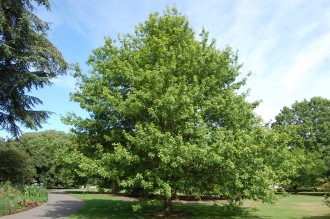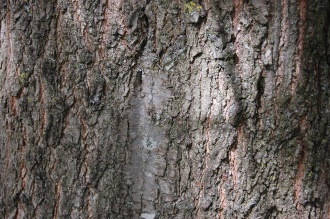Position: Full Sun
Flowering period: Spring
Soil: Moist, well drained
Eventual Height: 25m
Eventual Spread: 12m
Hardiness: 5a, 5b, 6a, 6b, 7a, 7b, 8a, 8b, 9a, 9b, 10a, 10b
Family: Fagaceae
Quercus texana is a fast growing deciduous tree with an irregular habit when young, becoming rounded as it matures. Its glossy mid green leaves are deeply lobed with up to 11 lobes, an irregularly toothed and spined margin, up to 20cm long and 13cm broad. Its leaves turn red/ orange in autumn before they fall. Its branches are glabrous and red/ brown to grey as they mature. Its bark is dark brown with orange/ brown shallow fissures. Its inflorescence is brown and inconspicuous. Its fruit is an ovoid acorn held in a cupule, up to 2.5cm long and 4cm across.
Quercus texana, commonly known as Nuttall’s Oak, Texas Red Oak, Spanish Oak or Red River Oak, is native to south east and central USA. In its native habitat it grows in flood plains and poorly drained soils. Quercus texana is synonymous with Quercus nuttallii and Quercus rubra var. texana
The etymological root of the binomial name Quercus is derived from the Latin name for an Oak tree, but some authorities believe it to be derived from the Celtic quer meaning ‘fine’ and cuez meaning ‘a tree’. Texana is derived from the Latin meaning ‘of or from texas’.
When available the landscape architect may find Quercus texana useful as a specimen tree with interesting autumn leaf colour and suitable for poorly drained soils.
Ecologically, Quercus texana acorns are eaten by mammals and some birds.
Quercus texana prefers moist, well-drained soils. It tolerates most pH of soil.
Quercus texana requires little maintenance.
![]()
Landscape Architecture







TQ. texans is not Q. nuttallii. The Texan oak is synonymous with “Spanish” oak, and found in central Texas extending into western Texas. It is a smaller tree than the Nutall oak, and found on well-drained alkaline soils, while the Nutall is a bottomland tree of acidic floodplain soils. Quercus texana may be a subspecies of Q. shumardii, or may hybridize with that species where the their ranges overlap in north central Texas. C. Colmenares, Texas horticulturist